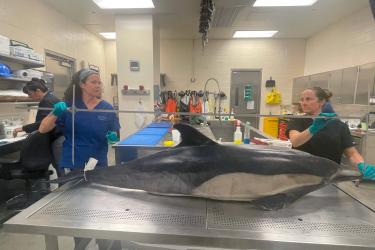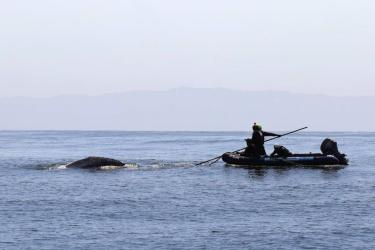Alexa Haucke and Jenna Callan interned with the Protected Resources Division of NOAA Fisheries’ West Coast Region under the Hollings Preparation Program. They are both University of Washington students. Jenna is a rising second-year undergraduate and Alexa will begin her first year after completing Running Start in high school. Here they describe their summer experience.
Through our internship, we worked with NOAA Fisheries and Seattle City Light on the Skagit River Hydroelectric Relicensing Project. It’s a multi-year project to reauthorize operations of the three Skagit River dams: Gorge Dam, Diablo Dam, and Ross Dam. We gained an understanding of how dams can affect Chinook salmon that spawn and rear in the Skagit River. We even did a site visit to tour the dams and learn about research on the reservoirs. The main focus of our project was to understand how changes in the abundance of threatened Skagit-origin Chinook salmon may affect endangered Southern Resident killer whales. These species are unequivocally connected, as Chinook salmon is the main food source for the Southern Residents.
Jenna Callan
My main project was compiling information to support an analysis of the effects of the Skagit River dams on Chinook salmon and Southern Resident killer whales. I evaluated how various factors, now under study, could affect Chinook salmon populations, such as:
- River flow rates
- Risk that fish could get drawn into dams
- Potential fish passage methods
I also researched potential effects of dams that are not currently being evaluated, such as rearing habitat limitations and the potential premature sexual maturation of Chinook salmon. My work will support NOAA Fisheries and Seattle City Light as they begin to evaluate if and how the Skagit River dams affect Southern Residents through impacts to their primary prey source, Chinook salmon.
Throughout the internship, I enjoyed learning more about policies such as those involved in the dam relicensing. I also enjoyed working with people from different departments and agencies, as we had mentors within both NOAA Fisheries and Seattle City Light. I gained a greater understanding of how agencies work together to accomplish their goals and the complexity of processes involved in government policy.
Alexa Haucke
My main goal was to understand the connection between Southern Residents and Skagit River Chinook salmon. NOAA Fisheries manages a wealth of data on Chinook salmon in the Skagit River and Southern Resident killer whales as part of Endangered Species Act recovery programs. For my project, I worked in R, a statistical coding language used by analysts worldwide. I used historical data on Chinook salmon and Southern Residents ranging from 1992 to 2015 to examine the relationship between them.
Overall, I found that both Skagit River salmon spawning populations and the presence of Southern Residents in Puget Sound varies year-to-year. Southern Resident sightings in Puget Sound appear to be somewhat correlated with spawning salmon population size. In other words, Southern Resident killer whales may be sighted more often in Puget Sound in years when the returning Skagit River Chinook salmon population is high. My analysis adds to a growing body of research on the relationships between Southern Residents and their prey. As part of the dam relicensing process, additional data is currently being collected and analyzed to help better understand the impacts of the dams on the Skagit River’s ecosystem.
I thoroughly enjoyed diving into NOAA Fisheries’ extensive collection of data and speaking with the vast array of experts working on the Skagit River project. It was inspiring to see so many different agencies come together on one project. I improved my communication and analytical skills through collaboration with mentors and colleagues at NOAA Fisheries, Seattle City Light, and connected agencies. I hope to continue exercising these skills throughout my career.



